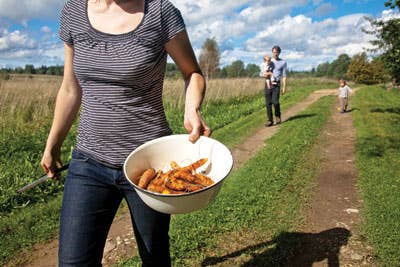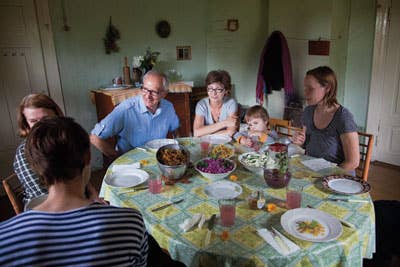
Riga Revisited: A Latvian Homecoming
A Latvian homecoming reveals how a family’s culinary traditions endure.
I am gazing out over the Central Market in Riga, Latvia, a massive complex stretching nearly 800,000 square feet across five former zeppelin hangars—repurposed remnants of a nearby WWI German airship base—on the east bank of the Daugava River. There are separate pavilions dedicated to fish, meat, produce, dairy, and bread, and they sprawl as far as the eye can see. I've heard about this market all my life, but until this moment, I'd never set eyes on it. My maternal grandmother, Rhoda Gurevich, was born in Riga, in 1926, and she used to shop here as a young girl with her mother, Anna Volpyansky. In her later years, my grandmother wrote a memoir in which she described the market's opulence; now, experiencing it with my parents on my first visit to Latvia, I feel like I am standing in her shoes.
Outside, scores of vendors offer all manner of local, foraged berries: red and black currants, lingonberries, cranberries, blackberries, and sea buckthorn, tiny, yellow berries that are deliciously sour. A woman spreads a blanket with chanterelles she harvested from the woods on the city's outskirts. We enter the fish pavilion, where the riches of Latvia's lakes, rivers, and ocean waters flop in shallow tubs: herring, eels, lamprey, hake, pike, and carp, which my great-grandmother used for gefilte fish. We try smoked smelts that look as though they've been dipped in gold and that taste of salt and smoke. In the meat pavilion, there are rows of rosy pink pork loin, used to make schnitzel-like karbonāde; ham hocks that have been smoked over alder wood; and speķis, cured and smoked lard, that melts on our tongues. Best of all is the dairy pavilion, where we find a food that my father has missed for years—a sweet, baked cheese made from jaunpiens, the milk of a cow that has just given birth—as well as an amazing array of the fresh cheeses and milk drinks, both cultured and curdled, that are a staple of the Latvian table. In another part of the market, we encounter the country's famed breads: rudzu salāskā maize, a wheat-rye mix with a dark brown crust and a pale, caraway seed—speckled crumb, and the one I like best for its deep, fermented flavor, a moist and dense loaf called klona maize. As we shop and taste, I imagine my great-grandmother walking through this place, her heels clacking on the cement floor, appraising the foods she would buy and prepare for her family.
Back in 1975, my parents, Anna and Edward Gershenson, emigrated from Riga to the United States with my older sister, Shulamit, then two years old, seeking to escape the punishing Soviet rule and start a new life. Returning was an emotional choice. My parents hadn't gone back to Latvia, a small country of about 2 million people wedged between the Baltic Sea and Russia, in 35 years, perhaps out of fear of what they might feel or encounter. For me, the first child in our family to be born in the States, Riga, Latvia's seaport capital, held an almost mythical status. I knew the city only through old photos, my parents' memories, and my grandmother's pride.
Rhoda Gurevich grew up in Latvia's most prosperous era during its first period of independence, between the world wars. She followed my parents to the U.S., where she spent the final two decades of her life. Despite the horror of the holocaust and its aftermath, in which 90 percent of the country's Jewish population was annihilated, including the majority of our family, my grandmother believed in the Riga she knew during earlier times: a place where cafe culture thrived, where Jugendstil architecture proliferated, and where she was educated in a Hebrew gymnasium, which defined her as a Zionist and a proud Rigan. In fact, the city's cosmopolitan reputation, about which I'd always heard, goes back centuries. Since its beginnings, in 1201, Riga was a vital Baltic port. During Soviet rule, when citizens from far-flung republics visited Latvia to experience the West, the capital's reputation was for high culture, nearby white-sand beaches, and delicious food. Over the centuries, Latvia belonged to many different countries—Germany, the Polish-Lithuanian Commonwealth, Sweden, and Russia—and these influences are reflected in the robust cuisine, where Eastern European ingredients like beets and soured dairy share the table with German pork dishes and Baltic fish.
Though my parents abandoned the old ways once they settled in Worcester, Massachusetts—they served no vodka at celebrations, no smoked or pickled fish, no candies from the Russian store—during the rare moments when they reflected positively on their former lives, the discussion always revolved around food. In recent years, I had become increasingly interested in my family's culinary history: It had dawned on me that the dishes I grew up eating—the salads of cucumber and tomato with sour cream; the whole, fried smelts; the cranberry mousse, a frothy concoction of farina, sugar, and cranberry juice that my grandmother would pour fresh milk over for added richness—were not Jewish, or Russian, as I had previously thought, but Latvian. So it seemed it was finally time to go back; time to get to know the place that had been a phantom influence on our American lives.

My mother, a caterer with a passion for baking, took early inspiration from the pastries that were sold in the city's many cafes and bakeshops, so when we arrived in Riga, this was one of the first foods we wanted to explore. She and my father used to frequent Cafe Nīca, on Lenin Street—now known by a Latvian name, Brīvības Iela—where one of their favorite desserts was chaynaya bulochka (Russian for tea bun), briochelike pastry sandwiching butter-enriched cream and crowned with a crunchy nut topping. In the state-run department store across from their apartment, my mother cherished the croissantlike rozovaya bulochka, or rose bun, its four corners pinched together to form a flaky pillow, and biezpienmaizīte, a yeast-dough tart filled with sweet cottage cheese and raisins.
On one of our first days in Latvia, we retrace the steps my parents once took through the Old City at Riga's center, with its serpentine cobblestone streets and mix of Romanesque, Gothic, Baroque, and Art Nouveau architecture. My parents still know the names of the streets and how to navigate them, but much has changed. The cafes my parents cherished have disappeared. In their place are tourist restaurants selling sushi, pizza, burgers, and Red Bull. My father used to relish the cremeschnitte, a cream-filled and iced puff pastry, from a shop called Vecrīga. Around the corner from the tall, travertine Freedom Monument, a symbol of Latvia's post—World War I era of independence, we discover one of two locations of this esteemed bakery; but when we sample the sweet, it is hard and wan, bearing no resemblance to the ethereal pastry my parents remember.
We wonder where Riga's famous cafe culture has gone. And though we know that the Central Market is brimming with ingredients, it also isn't obvious to us where Latvians go to eat. Unlike other capital cities, Riga doesn't have a tradition of street food, nor does it have a vibrant dining culture; most people eat at home. My Latvian-American friend Rich Kalnins, a journalist from Connecticut who moved to Riga in 2002, suggests we visit what he calls workman's cafeterias, self-service eateries based in high schools and municipal buildings, where traditional, simple foods are prepared from scratch. We meet Rich for lunch at a high school on Raiņa Bulvāris, a boulevard lined with embassies, university buildings, and other stately structures. He leads us to a side entrance, down a flight of stairs, and through a dark hall into a basement dining room painted an institutional mint green. Here, in this unlikely place, are the rustic dishes my father remembers eating as a student at Riga's Aeronautical Institute: sweet pancakes with homemade strawberry jam, potato pancakes with sour cream, boiled potatoes with dill, garlicky fried cutlets of pounded pork, earthy chilled beet soup, the requisite dark bread. Though I grew up with my parents' rhapsodizing about Riga's cafe culture, these are the staple foods that sustained them. And they taste wonderful.
A few days later, Rich invites us to dinner with his family at the summer cottage of his mother-in-law, Anita Rūtīte. We drive 90 minutes northeast of Riga, stopping along the way to chat with some foragers picking chanterelles by the roadside. Reaching the village of Launkalne, where we come upon Anita's cottage, a low, wooden structure surrounded by the fertile gardens that provide the family with the food they eat for much of the year. Even urban Latvians live off the land, Rich tells us as he greets us in the yard. "On August and September nights, you see people pulling up to their apartment buildings in Riga and unloading vegetables from their own farms or gardens," he says. "People grow their own food, not because it's trendy, but because it's a tradition that's been passed down."
Rich leads us into the kitchen, where Anita is at the stove, tending to the contents of a cast-iron pot: pork she bought at a nearby farm, and onions, garlic, potatoes, cabbage, tomatoes, and zucchini from her garden. With a smile, Rich's wife, Maija, puts my father, who rarely cooks, to work grating kohlrabi for a salad made with farmer's cheese and heavy cream. When he's finished, Maija hands him boiled beets to cube and toss with kidney beans, pickles, and sour cream. Maija has created most of these recipes herself, basing them on traditional flavors and the ingredients she has on hand. "You remind me of myself when I was a young mother," my mom tells her.
I follow Maija into the garden, where she plucks gnarled carrots from the earth for our soup, rinsing them off in a basin of rainwater. She is intimately familiar with every plant, herb, tree, and root that grows nearby. "Usually we cut quince in small pieces and put it in a jar with sugar for a beverage," she says. And then: "Here are milk apples, which are very good for jellies. The strawberries, we cut them down so they grow again next year. Do you see the Brussels sprouts? They'll be ready in one month." She pulls back an elephant-ear leaf to show me the miniature cabbages.
Following our dinner of stew, salads, and soup, Maija brings out a waffle iron—purchased "twenty years ago for nine rubles," she says—and plugs it into the wall to make fresh waffle cones to fill with a mixture of heavy cream, sugar, vanilla, cottage cheese, raspberries, and currants. It's a similar dessert, my mother says, to a treat called trubochki (Russian for cone) that she remembers from Riga's bakeshops. "This is the taste of the pastries that I loved," she says. "This is the taste I was looking for."
Days before our departure, Mārņtš Sirmais, a chef in Riga and a well-known promoter of traditional Latvian cuisine, invites us to the home of his friend and co-worker Stanislava Balsa, who lives on the right bank of the Daugava River with her daughter Renata, in a concrete, Soviet-era apartment building. Stanislava is originally from Lithuania, but she has been in Riga for almost 50 years, and Mārņtš calls her one of the best home cooks he's ever met. Her specialties, he says, are rustic but deeply flavorful Latvian comfort foods that reflect the country's culinary influences: speķa pīrāgi, Latvian bacon turnovers, likely a remnant of the early German period; selyodka pod shuboy, literally translated as herring in a fur coat, a showy layered dish of salt-cured herring and vegetables; and traditional Latvian maizes zupa, or bread soup, a sweet pudding made from dried fruits and rye bread.

Stanislava is a smiling woman with a high bun of red hair and glittering gold teeth. She is also a force; she churns out dish after dish in her tiny kitchen. First she makes the tiny, football-shaped turnovers, pinching together rounds of dough filled with diced bacon and onion. Mārņtš gets started on a chanterelle cream sauce for Stanislava's karbonāde, which she dips in egg wash and flour in order to achieve a substantial crust. Next, Stanislava prepares the herring salad. On an oblong serving dish, she arranges the fish, covers it with a sauce of sour cream and mayonnaise, then atop that builds layers of grated beets, boiled potatoes, and sour apple. She adorns her salad with alternating stripes of fresh dill and hard-cooked egg white and egg yolk, the way my grandmother used to decorate her chopped liver.
Stanislava's kitchen is too small for all of us to help. My parents retire to her living room, and I go in to check on them, carrying a tray of tea, rye bread, and caraway-speckled cheese. I walk in on my mother reading to my father; she has taken a volume of poetry by Pushkin from Stanislava's shelf. My father joins along, reciting the words from memory: "An eagle that has soared from off some distant cliff, / Lawless as I, sweeps through the radiant air! / Here I see streams at their sources up-welling, / The grim avalanches unrolling and swelling! / The soft cloudy convoys are stretched forth below…"
He is fighting back tears. My parents came to Riga after 35 years, linking their pasts to their present. It's not what any of us expected, but it feels like home.
Keep Reading
Continue to Next Story










